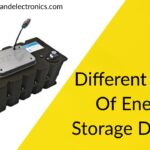Different Types Of Energy Storage Devices To Store Electricity
Hello guys, welcome back to my blog. In this article, I will discuss the different types of energy storage devices to store electricity, how to store energy or how to save energy, equipment that can be utilized to store energy, etc.
If you have any doubts related to electrical, electronics, and computer science, then ask question. You can also catch me @ Instagram – Chetan Shidling.
Also, read:
- Top 20 Power Systems Projects For MTech Students, Engineering Students
- Top 20 Control System Projects For MTech Students, Engineering Students
- How To Calculate RPM Of DC And AC Motor, Formula To Calculate RPM
Different Types Of Energy Storage Devices
- Capacitor
- Batteries
- Fossil fuel storage
- Flywheel energy storage
- Superconducting magnetic energy storage
- Compressed air energy storage
- Cryogenic energy storage
- Pumped storage hydraulic electricity
- Tesla powerpack/powerwall and many more
Here only some of the energy storage devices and methods are discussed.
01. Capacitor
It is the device that stores the energy in the form of electrical charges, these charges will be accumulated on the plates. It will store the energy as it can store charges with the number of charges on the capacitor, as it stores the charges and charging & discharging take place.
When the switch is connected, it starts to store the energy but when the switch is off it discharges the charges such that the device will be on even when the device will be off. Here when the charged capacitor is disconnected from the switch then energy remains in the field in the space between its plates.
This will pass all the alternating currents without passing direct currents. here if we see the difference between battery and capacitor then the battery will convert the chemical energy into electrical energy and the capacitor stores energy physically, in a form very much like static energy.
It has characteristics like:
- It has the best nominal capacitance.
- It has a high tolerance.
- It has high leakage current.
- The temperature will affect the capacitance.
- Polarization is the main characteristic of it, based on polarization the capacitor is divided into the polarized capacitor and unpolarized capacitor.
The amount of energy stored depends on the charge stored on the capacitor plates. The number of energy stores also depends upon the voltage across the capacitor that is formulated by:
W=½ Q²/C
Where W is energy stored in the capacitor, Q is the amount of charge stored in the capacitor and C is the capacitance value.
02. Batteries
The battery is an energy storage device that enables energy from renewable resources like solar and wind to be stored and released when the customer is in need. It is possible to store the energy in the form of the electrochemical present in that which will convert chemical energy into electrical energy.
This electrochemical cell has an anode and cathode where the positive terminal is the cathode and the negative terminal is the anode, these are found in many devices such as phones, television remote controllers, electric cars.
If we see the working of the battery as an energy storage system, then it captures the DC energies which are being produced by the renewable sources, it stores the energy in the form of DC power for later use. Here generally charging, optimization, discharging takes place. It is widely used by many electronics and electrical circuits.
03. Fossil Fuel Storage
Here energy is stored in fossil fuels. the renewable resources will store the energy and this energy is liberated when it is used as fossil fuels. Fossils such as coal and gasoline will store the energy that will be released from renewable resources like sunlight will be taken and further, when it has died it will be buried for a longer period. Later when it is converted into fuel then it is used as energy for many purposes.
04. Flywheel Energy Storage
It is a device that works by accelerating the rotor to a very high speed. It will maintain the energy in the form of rotation called rotational energy. When there will be energy extraction of the system the rotational speed of the flywheel is reduced as a consequence of the principle of conservation of energy.
Here it uses electricity to develop acceleration such that mechanical energy is produced, so we can conclude that it converts and stores electrical energy into mechanical energy. It has rotors made up of high-strength carbon fibers. this fiber is suspended by the magnetic bearing and spinning at the rate of 20,000 to over 50,000 rpm in a vacuum.
The mechanical that stores energy will be in the form of a moment of inertia, angular velocity, stored rotational energy. This device uses a mechanical bearing that can lose 20% to 60% of energy in two hours.
05. Superconducting Magnetic Energy Storage
It is system storage energy that is developed such that it stores the energy in the form of the magnetic field that is created by the flow of direct current in the superconducting coil that is cooled below the superconducting critical temperature.
This energy storage includes three parts: one is the superconducting coil, the second is the power conducting system, and the cryogenically cooled refrigerator. Here shortly once the superconducting is charged the current will not be released and magnetic energy is stored indefinitely. This stored energy is released back to the network by discharging the coil.
Here power condition system uses the inverter or rectifier to transform alternating current into direct current or vice versa. But the inverter or rectifier will use 2 to 3% of energy, that is 2 to 3% of energy is lost here.
Here the main advantages over all the devices are time delay during charging and discharging is shorter and power is available almost instantly, also very high output can be provided in a short period of time. Here loss of power is also less as compared to other storage devices.
06. Compressed Air Energy Storage
The energy is produced by using compressed air. In this storage, constant volume and constant pressure are stored. Here if we see the working when the air is trapped and compressed such that it produces the heat thus by producing the energy. It is the way where the energy is generated at one time and released at another time.
The energy generated during this will meet lower energy demand but also can meet higher energy demand. This CAES system stores the energy by using off-peak electricity by compressing the air and stored it in a reservoir.
07. Pumped Storage Hydraulic Electricity
It is a device that uses water reservoirs as a resource so it is called a hydroelectric storage device. It is a configuration of two water reservoirs at different elevations that generate power as water moves from one to another side while passing through the turbine. It converts and stores mechanical energy into electrical energy. This system requires power as the water moves from the upper reservoir. It is quite similar to the giant battery which stores the energy and is released whenever it is needed. There are two types of storage hydro-powers:
a. Open-loop storage hydropower that has an ongoing hydraulic connection to the natural water bodies.
b. Closed-loop storage hydro powers are not connected to outside waterbodies.
This was about different types of energy storage devices to store electricity. I hope this article ” Different Types Of Energy Storage Devices ” may help you all a lot. Thank you for reading ” Different Types Of Energy Storage Devices “.
Also, read:
- 10 Tips To Maintain Battery For Long Life, Battery Maintainance
- 10 Tips To Save Electricity Bills, Save Money By Saving Electricity
- 100 (AI) Artificial Intelligence Applications In The Automotive Industry
- 100 + Electrical Engineering Projects For Students, Engineers
- 1000+ Control System Quiz, Top MCQ On Control System
- 1000+ Electrical Machines Quiz, Top MCQs On Electrical Machines
- 1000+ MATLAB Simulink Projects For MTech, Engineering Students
- 50 Tips To Save Electricity At Home, Shop, Industry, Office







